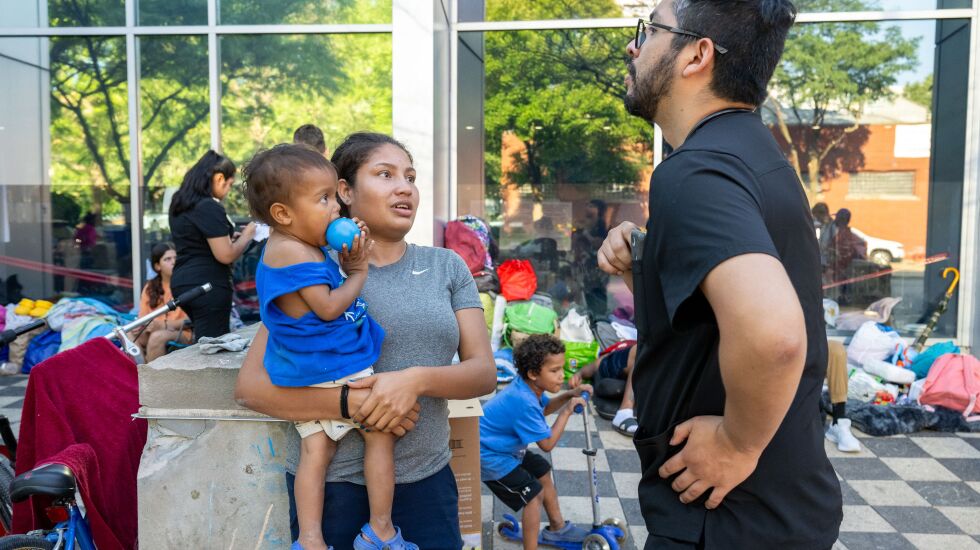
Nearly a year ago, Texas Gov. Greg Abbott began busing asylum seekers to Chicago.
It felt like an ambush. Former Mayor Lori Lightfoot’s administration had heard rumblings it could happen here when Abbott started using vulnerable, desperate migrants as pawns by sending them — without notice — to other liberal-leaning cities, to the cheers of many conservatives.
Since the first arrivals in Chicago on Aug. 31, 2022, more than 13,000 people have been sent here by bus and plane. Some have arrived with head lice or communicable diseases, including tuberculosis, a source close to the Lightfoot administration told us. At least two migrants weren’t able to complete the trip at all. A 3-year-old girl from Venezuela died on a bus en route to Chicago two weeks ago; a man last week had a seizure and had to be removed for treatment, a state official told us.
At the outset of this crisis, Gov. J.B. Pritzker had a visible presence as he declared the state a disaster area to make emergency spending and resources accessible. The state played a crucial role in finding temporary shelter for the asylum seekers in hotels, including some in the suburbs. Within months, those people were transitioned to housing.
The state also has kicked in tens of millions of dollars to ease the burden on Chicago.
But Chicago needs even more from the state, as the city closes in on a year of coping with a crisis that shows no sign of letting up.
City Hall anticipates that in advance of the 2024 Democratic National Convention, Abbott will keep sending asylum seekers in an effort to embarrass the city in front of a global audience, as Sun-Times City Hall reporter Fran Spielman reported Monday.
Coordinating city, suburban efforts
Look at police station floors where migrants are sleeping, or tent encampments, and it’s clear that the city is overwhelmed.
Unfortunately, there seems little likelihood of more federal funding to help. Through July, the Federal Emergency Management Agency had kicked in $14.9 million, a fraction of the $50 million Chicago received from the Illinois Department of Human Services. The state has doled out millions more in emergency aid for services ranging from short-term rental assistance to medical care.
In all, the state says it spent about $190 million in fiscal year 2023 to support new arrivals.
The state also is helping to convert a former CVS pharmacy in Little Village into a temporary shelter for asylum seekers. We hope they don’t stop there. As long as asylum seekers continue coming, there will be a need for more shelters.
It’s up to the city to reach out for help. “We let them lead because it is their administration, their jurisdiction,” Illinois Deputy Gov. Sol Flores told us.
The state, we think, could be more aggressive in trying to find suburban, or even downstate communities, willing to take in asylum seekers arriving in Chicago. It’s encouraging that the Pritzker administration is releasing $42.5 million to suburbs willing to do so, through a joint effort by the Metropolitan Mayors Caucus, the city, Cook County and the state to create a network of coordinated care for asylum seekers as they await work permits and transition to housing.
“We’re not going to do what Texas is doing, right?” Cristina Pacione-Zayas, Mayor Brandon Johnson’s deputy chief of staff, told us. “They don’t contact us. We get partial information if we’re lucky. What we want to do is have that partnership with our neighboring municipalities, villages and suburbs so that we can coordinate in a dignified way. You don’t want to just treat people like widgets.”
Elusive work permits
Those seeking asylum are eager to work, but they need permits from the federal government. That process is now taking a year, according to staff at the Washington, D.C.-based American Immigration Council. A bill the group supports would cut down the waiting period by several months, but the proposal will go nowhere in the U.S. House, where Republicans hold a majority.
For good reason, the lengthy work permitting process is frustrating for city and state leaders, as well as immigrant advocacy groups. Once asylum seekers can work — and there is certainly a worker shortage in many American industries — they can survive on their own.
But with more federal help unlikely any time soon, it’s up to cities and states to manage the crisis — and fast.
The Sun-Times welcomes letters to the editor and op-eds. See our guidelines.







